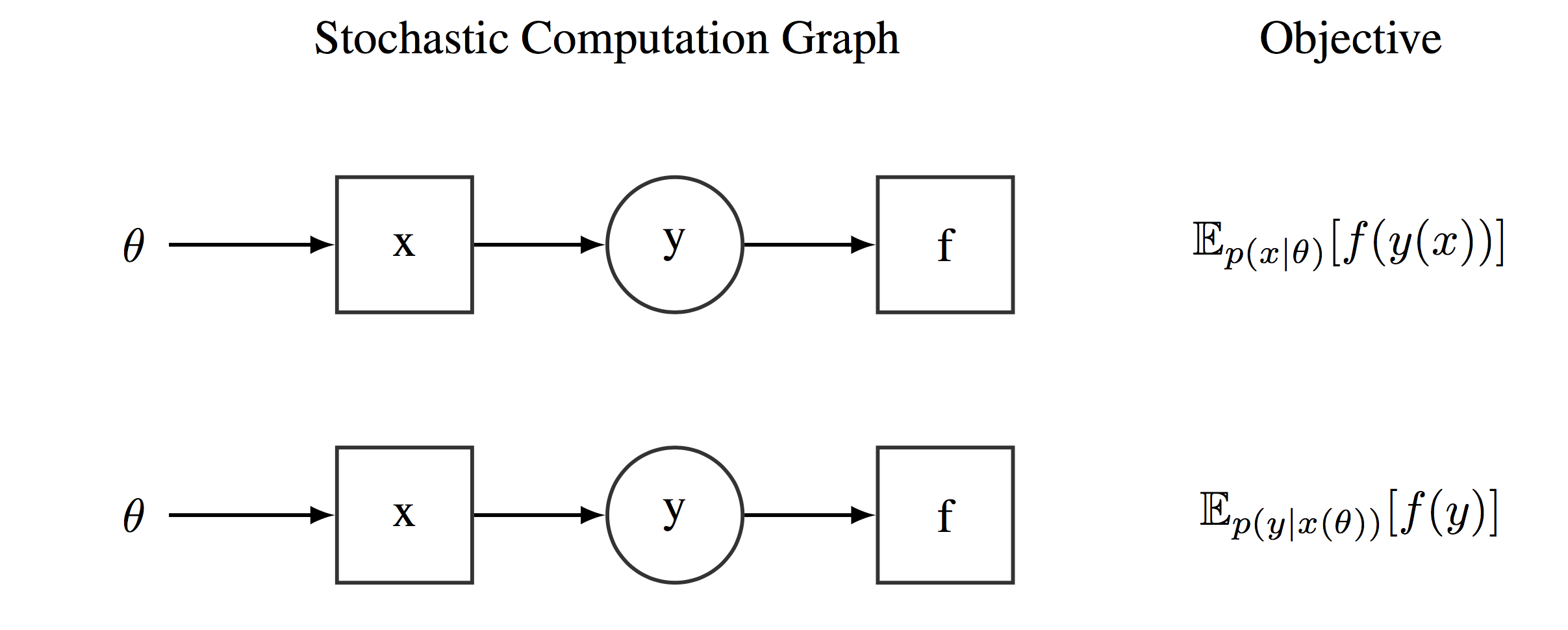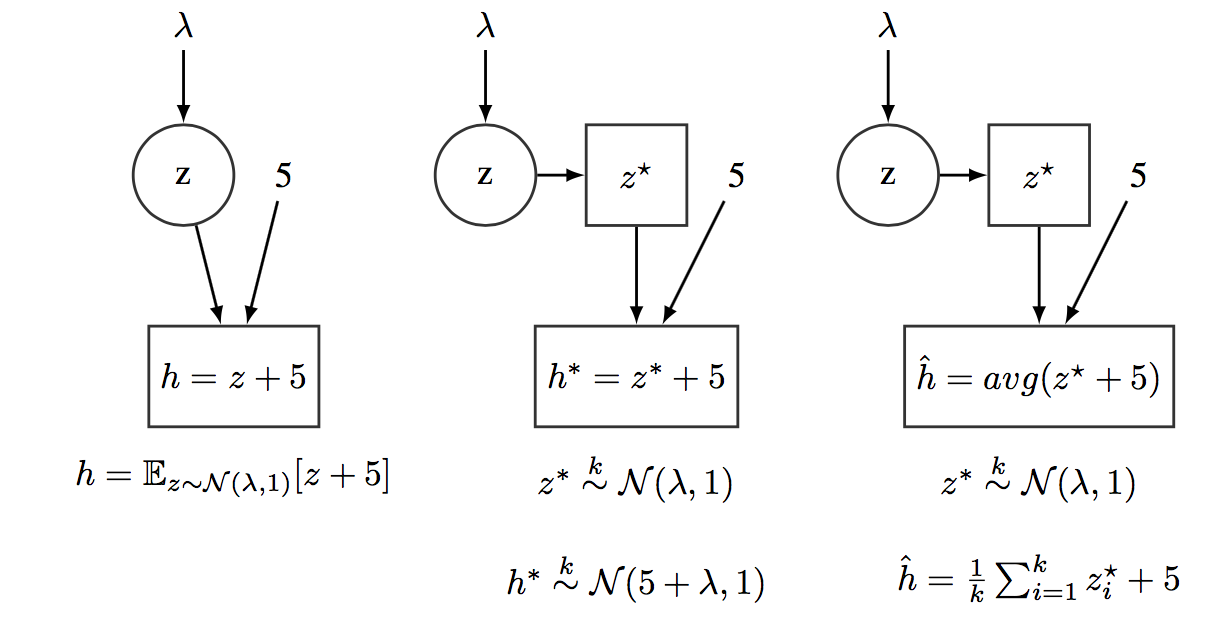Deep Probabilistic Modeling (IV). Probabilistic models with deep neural networks.
How deep neural networks can be used to extend the modelling capacities of a probabilistic model.
Deep Latent Variable Models
LVMs has been usually restricted to the conjugate exponential family because, in this case, the inference was feasible (and scalable). But recent advances in variational inference are inspiring many recent works extending LVMs with DNNs. Variational Auto-encoders (VAE) [@kingma2013auto; @doersch2016tutorial] are probably the most influential work combining LVMs and deep neural networks. VAEs extend the classic technique of principal component analysis (PCA) [@jolliffe2011principal] for data representation in lower-dimensional spaces. More precisely, [@kingma2013auto] extends the probabilistic version of the PCA model [@tipping1999probabilistic] where the relationship between the low-dimensional representation and the observed data is governed by a DNN, i.e. a highly non-linear function, as opposed to the standard linear assumptions of the basic version of the PCA model. These new models were able to capture much more compact low-dimensional representation especially in cases where data were highly-dimensional and complex1. As it is the case of image data [@kingma2013auto; @kulkarni2015deep; @gregor2015draw; @sohn2015learning; @pu2016variational], text data [@semeniuta2017hybrid], audio data [@hsu2017learning], chemical molecules [@gomez2018automatic], to name some of the most representative applications of this technique.
As commented above, VAEs have given rise to a plethora of extensions of classic LVMs to their deep countepart. [@johnson2016composing] contains different examples of this approach and proposes extensions of Gaussian mixture models, latent linear dynamical systems and latent switching linear dynamical systems with non-linear relationships modelled by DNNs. [@linderman2016recurrent] extends hidden semi-Markov models with recurrent neural networks. [@zhou2015poisson; @card2017neural] extends popular LDA models [@blei2003latent] for uncovering topics in text data. Many other works are following this same trend [@chung2015recurrent; @jiang2016variational; @xie2016unsupervised; @louizos2017causal].
LVMs with DNNs can also be found in the literature under the name of deep generative models [@hinton2009deep; @hinton2012practical; @goodfellow2014generative; @salakhutdinov2015learning]. These models highlight their capacity to generate data samples using probabilistic constructs that include DNNs. This new capacity has also provoked a strong impact within the deep learning community because has opened the possibility of dealing with unsupervised learning problems, as opposed to the classic deep learning methods which were mainly focused on supervised learning settings. In any case, this active area of research is out of the scope of this post and contains many alternative models which do not fall within the category of models explored in this work [@goodfellow2014generative].
Probabilistic Programming Languages and Stochastic Computational Graphs
One of the main reasons fueling the wide adoption of deep learning has been the availability of (open-source) software tools containing robust and well-tested implementations of the main building blocks for defining and learning DNNs [@chen2015mxnet; @abadi2016tensorflow; @paszke2017automatic].
Recently, a new wave of software tools is building up on top of these deep learning frameworks to accommodate modern probabilistic models containing deep neural networks [@tran2016edward; @cabanasInferPy; @tran2018simple; @bingham2018pyro]. These software tools usually fall under the umbrella of the so-called probabilistic programming languages (PPLs) [@gordon2014probabilistic; @ghahramani2015probabilistic], which are programming languages focused on describing general probabilistic models and powered by a general inference engine. Although they have been present in the field of machine learning for many years, this first generation of PPLs was mainly focused on defining a flexible language to express probabilistic models which were more general than the traditional ones usually defined by means of a graphical model [@koller2009probabilistic]. The advent of deep learning and the development of probabilistic models containing DNNs has motivated the development of a new family of PPLs [@tran2016edward; @cabanasInferPy; @tran2018simple; @bingham2018pyro] able to define probabilistic models containing DNNs.
The key data structure in these new PPLs are the so-called a stochastic computational graphs (SCGs) [@schulman2015gradient]. Stochastic computational graphs extends standard computational graphs with stochastic nodes. Stochastic nodes are distributed conditionally on their parents and are represented as circles in the subsequent diagrams. Stochastic computational graphs allow then to define complex functions involving expectations over random variables. Figure [fig:StochasticCG] shows several examples of some simple stochastic computational graphs depending on a parameter vector $\lambda$. Modern PPLs offer a wide and diverse range of probability distributions to define stochastic computational graphs [@dillon2017tensorflow]. And these probability distributions are defined over tensors objects.
[]
 Examples of two computational graphs encoding two different expectations
Examples of two computational graphs encoding two different expectations
We should note that SCGs are not directly implemented within the PPLs, because computing the exact expected value of complex functions is usually not feasible. However, they are indirectly coded on top of the existing computational graph’s framework. In this way, each stochastic node, $\bmz$, is associated with a tensor, $\bmz^\star$, which represents a (set of) sample(s) from the distribution associated to $\bmz$. $\bmz^\star$ is the tensor which is fed to the underlying computational graph. So, SCGs are simulated using standard computational graphs and samples from the defined probability/densities distributions. Figure [fig:EvaluatingStochasticCG] illustrates different possibilities about how SCG can be simulated using standard CGs.
[]
 (Left) A stochastic computational graph encoding the function $h=E_{z}[z + 5]$, where $z\sim N(\lambda,1)$. (Center) Computational graph processing $k$ samples from $z$ and producing $h^\star$ containing $K$ samples from $N(\lambda+5,1)$. (Right) Computational graph processing $k$ samples from $z$ and producing $\hat{h}$, an estimate of $E_z[z + 5]$. Note that CGs efficiently operate with tensors, with current toolbox like Tensorflow exploiting high-performance computing hardware such as GPUs or TPUs. So, its much more efficient to run the CG once over a bunch of samples, than running multiple times the CG over a single sample.
(Left) A stochastic computational graph encoding the function $h=E_{z}[z + 5]$, where $z\sim N(\lambda,1)$. (Center) Computational graph processing $k$ samples from $z$ and producing $h^\star$ containing $K$ samples from $N(\lambda+5,1)$. (Right) Computational graph processing $k$ samples from $z$ and producing $\hat{h}$, an estimate of $E_z[z + 5]$. Note that CGs efficiently operate with tensors, with current toolbox like Tensorflow exploiting high-performance computing hardware such as GPUs or TPUs. So, its much more efficient to run the CG once over a bunch of samples, than running multiple times the CG over a single sample.
Stochastic computational graphs allow defining quite general probabilistic models, potentially including complex deterministic relationships as DNNs. All the concepts review in this post applies to any probabilistic model which can be defined by means of a stochastic computational graph. Even though, the following equation provides a general characterization covering most of the models discussed in this post in terms of a deep LVM. We introduce this characterization because it will be easier for the reader to trace back a connection with the models and concepts commented in previous posts.
[] \(\begin{aligned} \label{eq:dnnexponentialform} \ln p(\bmbeta) &=& \ln h(\bmbeta) + \bmalpha^T t(\bmbeta) - a_g(\bmalpha)\nonumber\\ \ln p(\bmz_i|\bmbeta) &=& \ln h(\bmz_i) + \eta_z(\bmbeta)^T t(\bmz_i) - a_z(\eta_z(\bmbeta))\nonumber\\ \bmh_0 &=& a_0(\bmz_i^T\bmbeta_0)\nonumber\\ &\ldots &\nonumber\\ \bmh_{l} &=& a_l(\bmh_{l-1}^T\bmbeta_{l-1})\nonumber\\ &\ldots &\nonumber\\ \bmh_L &=& a_L(\bmh_{L}^T\bmbeta_L)\nonumber\\ \ln p(\bmx_i|\bmz_i,\bmbeta) &=& \ln h(\bmx_i) + \eta_x(\bmh_L)^T t(\bmx_i) - a_x(\eta_x(\bmh_L)).\end{aligned}\)
As can be seen, the main difference with respect to standard LVMs is the conditional distribution over the observations $\bmx_i$ given the local hidden variables $\bmz_i$ and the global parameters $\bmbeta$. Now, this conditional relationship is governed by the DNN parameterized by $\bmbeta$. The DNN affects how the hidden variable $\bmz$ defines the parameters of the conditional distribution $p(\bmx\given\bmz)$. Note that the DNN does not directly relate $\bmz$ with $\bmx$. A graphical description of this new model can be found in Figure [fig:DNNModel].
[]
 Core of the probabilistic model examined in this post.
Core of the probabilistic model examined in this post.
Deep exponential family models [@ranganath2015deep] would be a straightforward extension of this model family which is not covered here. It includes different hierarchies of latent variables which gives rise to a more expressive model family. But all the inference methods revised in this work would apply to these more complex models with minor adaptations.
Example 4: The Generative part of Variational Auto-Encocer
As commented above, Variational Auto-encoders are widely adopted LVM containing DNNs [@kingma2013auto]. Algorithm [alg:vae] provides a simplified pseudo-code description of the generative model of a VAE.
This model is quite similar to the PCA model presented in Example [example:PCA]. The main difference comes from the conditional distribution of $\bmx_i$. In the PCA model, the mean of the Normal distribution of $\bmx_i$ depends linearly on $\bmz_i$ through $\bmbeta$. In the VAE model, the mean depends on $\bmz_i$ through a DNN parametrized by $\bmbeta$, this DNN is known as the decoder network of the VAE [@kingma2013auto]. Note that the original formulation of this model also includes another DNN which connects $\bmz_i$ with the variance of the Normal distribution of $\bmx_i$. It easy to see that this model belongs to the model family described by Equations [eq:dnnexponentialform].
References
Abadi, Martı́n, Paul Barham, Jianmin Chen, Zhifeng Chen, Andy Davis, Jeffrey Dean, Matthieu Devin, et al. 2016. “Tensorflow: A System for Large-Scale Machine Learning.” In OSDI, 16:265–83.
Bingham, Eli, Jonathan P Chen, Martin Jankowiak, Fritz Obermeyer, Neeraj Pradhan, Theofanis Karaletsos, Rohit Singh, Paul Szerlip, Paul Horsfall, and Noah D Goodman. 2018. “Pyro: Deep Universal Probabilistic Programming.” arXiv Preprint arXiv:1810.09538.
Blei, David M, Andrew Y Ng, and Michael I Jordan. 2003. “Latent Dirichlet Allocation.” Journal of Machine Learning Research 3 (Jan): 993–1022.
Cabañas, Rafael, Antonio Salmerón, and Andrés R. Masegosa. 2019. “InferPy: Probabilistic Modeling with Tensorflow Made Easy.” Knowledge-Based Systems.
Card, Dallas, Chenhao Tan, and Noah A Smith. 2017. “A Neural Framework for Generalized Topic Models.” arXiv Preprint arXiv:1705.09296.
Chen, Tianqi, Mu Li, Yutian Li, Min Lin, Naiyan Wang, Minjie Wang, Tianjun Xiao, Bing Xu, Chiyuan Zhang, and Zheng Zhang. 2015. “Mxnet: A Flexible and Efficient Machine Learning Library for Heterogeneous Distributed Systems.” arXiv Preprint arXiv:1512.01274.
Chung, Junyoung, Kyle Kastner, Laurent Dinh, Kratarth Goel, Aaron C Courville, and Yoshua Bengio. 2015. “A Recurrent Latent Variable Model for Sequential Data.” In Advances in Neural Information Processing Systems, 2980–8.
Dillon, Joshua V, Ian Langmore, Dustin Tran, Eugene Brevdo, Srinivas Vasudevan, Dave Moore, Brian Patton, Alex Alemi, Matt Hoffman, and Rif A Saurous. 2017. “TensorFlow Distributions.” arXiv Preprint arXiv:1711.10604.
Doersch, Carl. 2016. “Tutorial on Variational Autoencoders.” arXiv Preprint arXiv:1606.05908.
Ghahramani, Zoubin. 2015. “Probabilistic Machine Learning and Artificial Intelligence.” Nature 521 (7553): 452.
Goodfellow, Ian, Jean Pouget-Abadie, Mehdi Mirza, Bing Xu, David Warde-Farley, Sherjil Ozair, Aaron Courville, and Yoshua Bengio. 2014. “Generative Adversarial Nets.” In Advances in Neural Information Processing Systems, 2672–80.
Gordon, Andrew D, Thomas A Henzinger, Aditya V Nori, and Sriram K Rajamani. 2014. “Probabilistic Programming.” In Proceedings of the on Future of Software Engineering, 167–81. ACM.
Gómez-Bombarelli, Rafael, Jennifer N Wei, David Duvenaud, José Miguel Hernández-Lobato, Benjamı́n Sánchez-Lengeling, Dennis Sheberla, Jorge Aguilera-Iparraguirre, Timothy D Hirzel, Ryan P Adams, and Alán Aspuru-Guzik. 2018. “Automatic Chemical Design Using a Data-Driven Continuous Representation of Molecules.” ACS Central Science 4 (2): 268–76.
Gregor, Karol, Ivo Danihelka, Alex Graves, Danilo Jimenez Rezende, and Daan Wierstra. 2015. “Draw: A Recurrent Neural Network for Image Generation.” arXiv Preprint arXiv:1502.04623.
Hinton, Geoffrey E. 2009. “Deep Belief Networks.” Scholarpedia 4 (5): 5947.
———. 2012. “A Practical Guide to Training Restricted Boltzmann Machines.” In Neural Networks: Tricks of the Trade, 599–619. Springer.
Hsu, Wei-Ning, Yu Zhang, and James Glass. 2017. “Learning Latent Representations for Speech Generation and Transformation.” arXiv Preprint arXiv:1704.04222.
Jiang, Zhuxi, Yin Zheng, Huachun Tan, Bangsheng Tang, and Hanning Zhou. 2016. “Variational Deep Embedding: An Unsupervised and Generative Approach to Clustering.” arXiv Preprint arXiv:1611.05148.
Johnson, Matthew, David K Duvenaud, Alex Wiltschko, Ryan P Adams, and Sandeep R Datta. 2016. “Composing Graphical Models with Neural Networks for Structured Representations and Fast Inference.” In Advances in Neural Information Processing Systems, 2946–54.
Jolliffe, Ian. 2011. “Principal Component Analysis.” In International Encyclopedia of Statistical Science, 1094–6. Springer.
Kingma, Diederik P, and Max Welling. 2013. “Auto-Encoding Variational Bayes.” arXiv Preprint arXiv:1312.6114.
Koller, Daphne, and Nir Friedman. 2009. Probabilistic Graphical Models: Principles and Techniques. MIT press.
Kulkarni, Tejas D, William F Whitney, Pushmeet Kohli, and Josh Tenenbaum. 2015. “Deep Convolutional Inverse Graphics Network.” In Advances in Neural Information Processing Systems, 2539–47.
Linderman, Scott W, Andrew C Miller, Ryan P Adams, David M Blei, Liam Paninski, and Matthew J Johnson. 2016. “Recurrent Switching Linear Dynamical Systems.” arXiv Preprint arXiv:1610.08466.
Louizos, Christos, Uri Shalit, Joris M Mooij, David Sontag, Richard Zemel, and Max Welling. 2017. “Causal Effect Inference with Deep Latent-Variable Models.” In Advances in Neural Information Processing Systems, 6446–56.
Paszke, Adam, Sam Gross, Soumith Chintala, Gregory Chanan, Edward Yang, Zachary DeVito, Zeming Lin, Alban Desmaison, Luca Antiga, and Adam Lerer. 2017. “Automatic Differentiation in Pytorch.”
Pless, Robert, and Richard Souvenir. 2009. “A Survey of Manifold Learning for Images.” IPSJ Transactions on Computer Vision and Applications 1: 83–94.
Pu, Yunchen, Zhe Gan, Ricardo Henao, Xin Yuan, Chunyuan Li, Andrew Stevens, and Lawrence Carin. 2016. “Variational Autoencoder for Deep Learning of Images, Labels and Captions.” In Advances in Neural Information Processing Systems, 2352–60.
Ranganath, Rajesh, Linpeng Tang, Laurent Charlin, and David Blei. 2015. “Deep Exponential Families.” In Artificial Intelligence and Statistics, 762–71.
Salakhutdinov, Ruslan. 2015. “Learning Deep Generative Models.” Annual Review of Statistics and Its Application 2: 361–85.
Schulman, John, Nicolas Heess, Theophane Weber, and Pieter Abbeel. 2015. “Gradient Estimation Using Stochastic Computation Graphs.” In Advances in Neural Information Processing Systems, 3528–36.
Semeniuta, Stanislau, Aliaksei Severyn, and Erhardt Barth. 2017. “A Hybrid Convolutional Variational Autoencoder for Text Generation.” arXiv Preprint arXiv:1702.02390.
Sohn, Kihyuk, Honglak Lee, and Xinchen Yan. 2015. “Learning Structured Output Representation Using Deep Conditional Generative Models.” In Advances in Neural Information Processing Systems, 3483–91.
Tipping, Michael E, and Christopher M Bishop. 1999. “Probabilistic Principal Component Analysis.” Journal of the Royal Statistical Society: Series B (Statistical Methodology) 61 (3): 611–22.
Tran, Dustin, Matthew W Hoffman, Dave Moore, Christopher Suter, Srinivas Vasudevan, and Alexey Radul. 2018. “Simple, Distributed, and Accelerated Probabilistic Programming.” In Advances in Neural Information Processing Systems, 7608–19.
Tran, Dustin, Alp Kucukelbir, Adji B Dieng, Maja Rudolph, Dawen Liang, and David M Blei. 2016. “Edward: A Library for Probabilistic Modeling, Inference, and Criticism.” arXiv Preprint arXiv:1610.09787.
Xie, Junyuan, Ross Girshick, and Ali Farhadi. 2016. “Unsupervised Deep Embedding for Clustering Analysis.” In International Conference on Machine Learning, 478–87.
Zhou, Mingyuan, Yulai Cong, and Bo Chen. 2015. “The Poisson Gamma Belief Network.” In Advances in Neural Information Processing Systems, 3043–51.
-
Technically, it refers to high-dimensional data which “lives” in a low-dimensional manifold [@pless2009survey]. ↩
